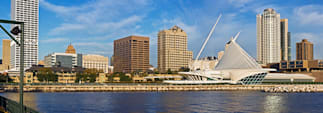I went on a couple of bike rides last weekend. On Saturday it was 50 degrees, damp and cold, and I saw some snow along the road. I had to stop and put my hat on under my helmet - but that may have something to do with being follically challenged.
Sunday it was in the mid-70s and I put on sunscreen before I went out. As Wisconsinites, we all know to expect the unexpected with spring weather, as anything can happen. (Interesting little tidbit: Did you know that while it snowed on April 1 this year, last year it was 81 degrees in Madison " an all-time record high?)
In today’s world, we need to expect the unexpected in both the physical world and the business world, which are ultimately interrelated. In the last decade, there have been unprecedented natural disasters with the Indonesian tsunami and the flooding in New Orleans from Hurricane Katrina, as well as unimaginable manmade events such as the 9/11 terrorist attacks and the subprime mortgage crisis that led to the Great Recession.
The current landscape includes the recent earthquake and tsunami in Japan, major political turmoil in multiple Middle Eastern and northern African countries, the price of oil being well over $100 a barrel, and gas pushing toward $4 a gallon. Yet foreign stock markets are up 5% for the year and domestic markets are up 6%. That seems a bit surprising to me, but maybe volatility is the new norm and somehow less unsettling.
The Great Recession affected virtually every business and individual. As asset values plummeted and unemployment skyrocketed, businesses took hits to their revenues like never before and business managers were faced with decisions never anticipated. This caused us all to change some of our ideas about planning.
If you plotted the likelihood of all possible future scenarios, you’d get a bell-shaped curve. Traditionally, one would build one’s business plan to address the most likely scenario – the middle of the bell curve. We also need to prepare for the worst-case scenario (the far left tail of the bell-shaped curve), as we learned from the recent recession. But what about the other tail?
Just as the volatile world created a fatter tail than anyone anticipated on the low/negative end, there may be scenarios that develop coming out of the recession that create a fatter tail and unanticipated opportunity on the positive/upper end. The interesting thing about the tail representing the worst-case scenario is if these events happen, you’ll be forced to react or suffer the consequences, however if the tail representing the opportunity presents itself, you’ll need to be proactive and take action to capitalize on it.
Often technology plays a significant role in these unexpected positive opportunities. How many of us a decade ago would have thought our cell phone would be as powerful as (or maybe even more powerful than) our desktop computers? That we could carry a tiny device with us everywhere we go that acts as a GPS and enables us to check and send email, jump out to a website to get immediate information, listen to music, and watch videos – it’s amazing. For many businesses, technological innovations like this have major implications related to product distribution, efficiency gains, customer service, etc.
Taking advantage of unexpected opportunity takes both a positive proactive mindset and preparedness. So while you are looking over your shoulder for the possible downside, are you also scanning the horizon, watching for opportunities, and ready to take full advantage of them? Are you keeping an eye on possible opportunities in your industry that could occur with a sustained recovery and/or the disruption of a major competitor? Are you thinking about advances in technology and how you could use that technology to benefit your clients? Is your organization nimble enough to take advantage when opportunities arise? Do you have the capital – financial and human – ready to deploy? Are you even looking for the opportunities, or are you only thinking of the downside?
Our world seems volatile and chaotic, but that doesn’t have to be all negative. In Chinese, the word "crisis" is composed of two characters – one represents danger and the other represents opportunity. So expect the unexpected on the downside, but prepare to capitalize on the unexpected opportunity on the upside. And if you go biking in the spring in Wisconsin, keep both your winter hat and sunscreen handy.





